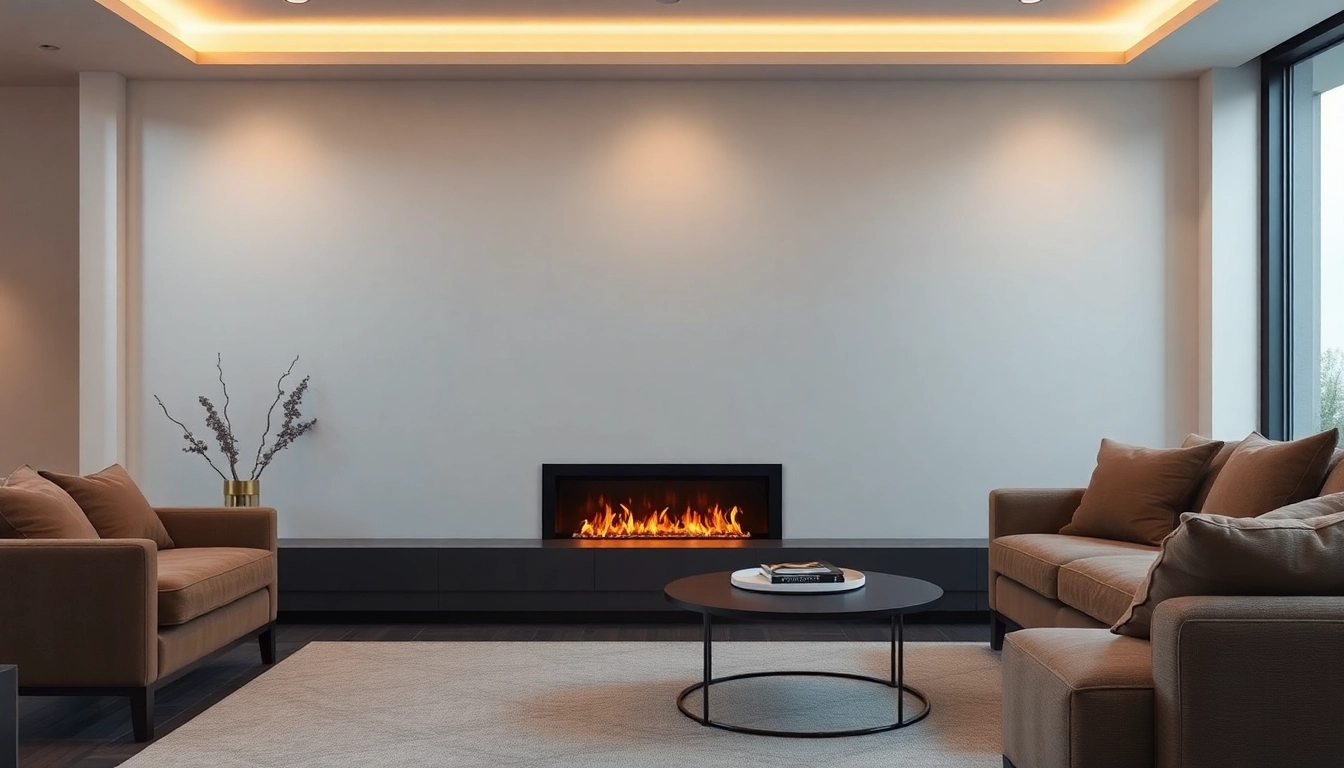1. Understanding Automatic Bioethanol Fireplaces
1.1 What is an Automatic Bioethanol Fireplace?
Automatic bioethanol fireplaces represent a significant advancement in the world of home heating and aesthetic design. These innovative appliances utilize bioethanol fuel, a renewable energy source derived from organic materials, producing a clean flame without the need for traditional venting systems. Unlike conventional fireplaces, which require extensive infrastructure like chimneys and flues, automatic bioethanol fireplaces are free-standing or can be integrated into existing decor seamlessly.
An automatic bioethanol fireplace is equipped with electronic controls, allowing users to ignite, adjust, and extinguish the flame at the touch of a button or through a smartphone app. This level of control not only enhances convenience but also dramatically improves the overall safety of using an indoor flame source.
1.2 Key Features and Benefits
One of the most appealing features of automatic bioethanol fireplaces is their convenience. With modern technology, many models come equipped with additional functionalities such as remote control, smartphone connectivity, and even compatibility with home automation systems like Amazon Alexa and Google Home. This means users can control their fireplace from anywhere in their home, adding to the central appeal of convenience.
Another key benefit is the virtually smoke-free burning process, which allows these fireplaces to be installed in a variety of indoor settings without requiring extensive modifications to ventilation systems. The clean burn of bioethanol fuel generates heat, flame, and minimal emissions, creating a cozy atmosphere without cumbersome cleanup or residual soot.
1.3 Environmental Impact of Using Bioethanol
From an environmental perspective, bioethanol fireplaces utilize a fuel source that is both renewable and sustainable. The production process for bioethanol often involves fermenting plants like corn, sugarcane, or even agricultural waste, making it far more sustainable than fossil fuels. Additionally, when burned, bioethanol emits significantly less particulate matter and harmful toxins than traditional wood-burning fireplaces, contributing positively to indoor air quality.
However, it is essential to consider the overall lifecycle of bioethanol production, as the cultivation and processing of biomass may also impact the environment. For informed consumers, choosing certified sustainable bioethanol can help mitigate some potential drawbacks associated with biofuel usage.
2. Advantages of Using an Automatic Bioethanol Fireplace
2.1 Convenience and Ease of Use
The convenience of automatic bioethanol fireplaces is arguably one of their most significant advantages. Users can start a fire with the push of a button, eliminating the need for kindling or manual ignition. This feature is especially beneficial for those who want to enjoy a fire without the cumbersome setup typically associated with traditional fireplaces.
Moreover, the ability to adjust the flame and heat output with precision allows users to create the perfect ambiance for any occasion effortlessly. Whether it’s a cozy night in or entertaining guests, having control at one’s fingertips transforms the way people enjoy indoor flames.
2.2 Safety Features to Consider
Safety is always a critical concern when it comes to indoor fireplaces. One of the hallmarks of automatic bioethanol fireplaces is their advanced safety mechanisms. Many models are equipped with features such as automatic shut-off sensors that detect when the unit is tipped over or if the flame goes out unexpectedly.
Additionally, top-of-the-line models may include sensor systems that monitor heat levels, ensuring a safe operation without overheating. These safety features not only protect your home but also provide peace of mind, especially for families with children and pets.
2.3 Aesthetic Appeal and Design Options
Beyond their functional advantages, automatic bioethanol fireplaces come in an array of styles and designs, making them a versatile choice for any interior decor. From minimalist configurations to more elaborate statement pieces, there’s a model to fit nearly every aesthetic preference.
The visual appeal of flames dancing in a contemporary setting offers a warmth and character that enhances any room, from modern living rooms to rustic cabins. Moreover, the transparent glass elements that many models incorporate blur the edges of the design, allowing the flickering flames to become the focal point of the space.
3. Buying Guide for Automatic Bioethanol Fireplaces
3.1 Factors to Consider When Purchasing
When considering the purchase of an automatic bioethanol fireplace, thoughtful evaluation of various factors is essential to ensure a satisfactory investment. The first consideration should be the size and scale of the fireplace. Ensure it fits within the space intended without overwhelming it or being too diminutive.
Another critical factor is the fireplace’s fuel consumption rate and the type of bioethanol it requires. Depending on how often it will be used, understanding operational costs and how long a tank of fuel lasts will help budget appropriately.
Features such as remote control and safety features are also paramount in deciding which model will best meet individual needs. Moreover, checking warranty options could provide additional security in case of mechanical failure.
3.2 Understanding Installation Requirements
One of the appealing aspects of automatic bioethanol fireplaces is their straightforward installation. Most units do not require professional installation, making them ideal for renters or those who do not wish to undertake major renovations. However, to optimize the fireplace’s performance and safety, it is crucial to familiarize oneself with any specific requirements related to placement, clearances, and fuel storage.
While some models are completely portable, others may need more consideration for permanent placement within a specific room. Always consult the manufacturer’s guidelines to ensure proper setup and compliance with safety regulations.
3.3 Pricing Insights and Budgeting
The purchase price of automatic bioethanol fireplaces can vary significantly based on brand, features, and design complexity. Entry-level models may start around $500, while more advanced or designer options can run well over $2,000. It’s crucial to evaluate not just the initial cost but also the long-term costs associated with fuel consumption and maintenance.
Budgeting should also account for fuel accessories like containers and additional bioethanol fuel, which will be ongoing costs. In the long run, understanding the full scope of expenses can help make a more informed purchasing decision.
4. Maintenance Tips for Your Automatic Bioethanol Fireplace
4.1 Routine Cleaning and Care
Maintaining your automatic bioethanol fireplace is vital for ensuring it operates optimally and lasts for years to come. Regular cleaning of the glass surfaces is essential to maintain visibility and aesthetic appeal. Most manufacturers recommend using a gentle glass cleaner and a soft cloth to avoid scratching the surface.
Additionally, the burner unit should be inspected regularly for signs of buildup, which can affect performance. Always refer to the manufacturer’s cleaning recommendations to avoid voiding warranties or damaging components.
4.2 Refueling and Usage Tips
Refueling your bioethanol fireplace is a straightforward process, but care must be taken to avoid spills or over-filling. Always allow the burner to cool completely before refueling and use a designated funnel for pouring the bioethanol fuel to minimize spills.
It’s also recommended to store fuel in a designated area far from live flames and to never attempt to refuel while the fireplace is operational. Following these guidelines will enhance both safety and performance during use.
4.3 Troubleshooting Common Issues
Even the best appliances can encounter issues over time. Common problems with automatic bioethanol fireplaces may include inconsistent flames or trouble igniting. If you encounter such issues, it might stem from a fuel blockage or a faulty ignition system.
If troubleshooting on your own does not resolve the problem, consulting the user manual or contacting customer support is always a beneficial step. Prompt maintenance and addressing any issues early can prevent more significant repairs down the line.
5. Frequently Asked Questions
5.1 Are Automatic Bioethanol Fireplaces Cost-effective?
While the initial investment for an automatic bioethanol fireplace can be higher than traditional fireplace options, the overall cost-effectiveness often balances out over time. The minimal need for installation modifications and the clean burn of bioethanol fuel results in lower maintenance costs and cleaning requirements.
Furthermore, considering bioethanol fuel prices and burn rates is essential. Depending on usage, some households may find that the cost of operating a bioethanol fireplace compares favorably to electric or gas options, particularly in homes lacking gas lines.
5.2 What Safety Measures Should Be Taken?
Safety measures are essential when using any indoor flame source. Users should ensure that the unit is placed away from flammable materials, and regular checks should be made to monitor fuel levels. It’s also wise to educate all household members on proper usage and emergency procedures should an incident arise.
Finally, utilizing all built-in safety features, such as automatic shut-off functions, is crucial for ensuring the safe operation of the fireplace.
5.3 Can Automatic Bioethanol Fireplaces Be Used Indoors?
Yes, automatic bioethanol fireplaces are designed for indoor use and are well-suited for creating a warm and inviting atmosphere without the drawbacks associated with traditional fireplaces. The clean-burning nature of bioethanol means they produce no smoke or harmful emissions, making them an excellent choice for homes.
However, proper ventilation is still recommended to maintain quality air within the space, particularly in small areas. As always, following the manufacturer’s guidelines ensures safe usage indoors.


